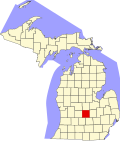St. Johns, Michigan | |
|---|---|
| City of St. Johns | |
 Clinton County Courthouse in downtown St. Johns | |
| Nicknames: "S.J.", "Mint City (U.S.A.)", "Mint Capital of the World" | |
 Location within Clinton County | |
| Coordinates: 43°00′02″N84°33′20″W / 43.00056°N 84.55556°W [1] | |
| Country | |
| State | |
| County | |
| Settled | 1853 |
| Incorporated | 1904 |
| Government | |
| • Type | Commission–manager |
| • Mayor | Scott Dzurka |
| • Manager | Chad Gamble |
| Area | |
• Total | 4.21 sq mi (10.91 km2) |
| • Land | 4.21 sq mi (10.91 km2) |
| • Water | 0 sq mi (0.00 km2) |
| Elevation | 791 ft (241 m) |
| Population (2020) | |
• Total | 7,698 |
| • Density | 1,827.1/sq mi (705.45/km2) |
| Time zone | UTC-5 (Eastern (EST)) |
| • Summer (DST) | UTC-4 (EDT) |
| ZIP code(s) | 48879 |
| Area code | 989 517 |
| FIPS code | 26-70940 [3] |
| GNIS feature ID | 1627030 [1] |
| Website | Official website |
St. Johns or Saint Johns [1] is the largest city in and the county seat of Clinton County in the U.S. state of Michigan. [4] The population was 7,698 at the 2020 census.
Contents
- Geography
- Demographics
- 2010 census
- Culture
- Mint production
- Transportation
- Highways
- Airports
- Notable people
- Places of interest
- Registered Historic Buildings in St. Johns
- Climate
- Crime rate
- See also
- References
- External links
St. Johns is located in the north of Clinton County, surrounded by Bingham Township (although the two are administered independently). St. Johns is about 18 miles (29 km) north of Lansing, Michigan's capital city, and is part of the Lansing–East Lansing metropolitan area. St. Johns has been nicknamed the "Mint Capital of the World". [5]










